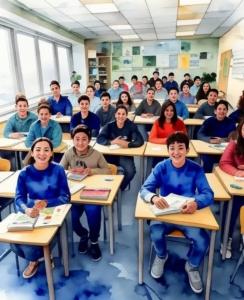🌱 Comprehensive Answer Set on ICSE Class 9 Seeds – Structure and Germination
Explore this detailed and engaging answer set covering multiple-choice, short answer, long answer, and diagram-based questions. Emojis are used for better understanding and engagement.
🌿 True or False
- ❌ False – Plumule is the future shoot and radicle is the future root of the plant.
- ✅ True – Micropyle allows the emergence of the radicle.
- ✅ True – Cotyledons in castor store food for the embryo.
- ✅ True – Maize grain has a large endosperm.
- ❌ False – Testa, not tegmen, is the outermost layer of the seed.
🌿 Fill in the Blanks
- In a dry seed, the embryo is in quiescent state.
- Water is absorbed by the seed mainly through micropyle.
- Very low temperature inhibits the growth of the embryo.
- Germination in Pea is epigeal.
- Coleoptile is a part found in the germinating maize.
- Alkaline pyrogallic acid is used for absorbing oxygen during experiments on germination.
🌿 Multiple Choice Questions
- c) Maize grain → coleoptile
- d) do not get enough oxygen.
- a) Ovary
- c) Double coconut
- c) Hilum
- b) Scutellum
- a) Testa
- d) Radicle
- d) All of the above.
🔍 Very Short Answer Type
- Correct the false statements:
- (a) Radicle develops into the root system.
- (b) Tegmen is the delicate inner layer of a seed’s outer covering.
- (c) Endothelium in maize grain separates the endosperm and the embryo.
- (d) Hypocotyl elongates faster in epigeal germination.
- (e) Dormancy marks a resting phase in the life of a seed.
- Name the following:
- (a) Maize
- (b) Pyrogallic acid
- (c) Epicotyl
- (d) Mangrove
- (e) Aleurone layer
- (f) Castor seed
- Fill in the blanks:
- (a) In bean seeds, the hypocotyl grows more rapidly, causing the seeds to emerge above the soil.
- (b) The coleorhiza acts as a shield for the radicle, while the coleoptile safeguards the curled plumule.
- (c) A seed is enclosed and protected by testa and tegmen.
- (d) Seeds intake water through the micropyle, which also aids in the diffusion of gases required for respiration.
- (e) Crops like rice, wheat, and maize are abundant in starch nutrients.
📝 Short Answer Type
- Definitions:
- Seed: A mature ovule containing an embryo, capable of developing into a new plant.
- Fruits: The ripened ovary of a plant, containing seeds.
- Grain: A small, hard, dry seed, with or without an attached hull.
- Dormancy: A period during which growth and development are temporarily stopped.
- Germination: The process by which a seed develops into a new plant.
- Difference between embryo and seed:
- Embryo: The young developing plant inside a seed.
- Seed: The mature ovule containing the embryo and food reserve, enclosed by a seed coat.
- Germinated grams are highly nutritive because germination increases vitamin content and makes nutrients easier to digest.
- Maize fruit and seed are not termed separately as the fruit wall and seed coat are fused, forming a caryopsis.
📚 Long Answer Type
- Distinguish between:
- (a) Monocotyledonous: One cotyledon (e.g., maize); Dicotyledonous: Two cotyledons (e.g., bean).
- (b) Epicotyl: Part of the embryo above cotyledons; Hypocotyl: Part of the embryo below cotyledons.
- (c) Epigeal: Cotyledons emerge above soil; Hypogeal: Cotyledons stay underground.
- (d) Radicle: Develops into the root; Plumule: Develops into the shoot.
- (e) Albuminous: Seeds with endosperm (e.g., maize); Exalbuminous: Seeds without endosperm (e.g., bean).
- Functions:
- Seed coat: Protects the embryo.
- Micropyle: Allows water and oxygen to enter the seed.
- Cotyledons: Store food for the embryo.
- Radicle: Develops into the root.
- Plumule: Develops into the shoot.
- Experiment to prove temperature is necessary for germination:
- Take two sets of seeds. Place one in a warm environment and another in a cold one.
- Provide both with water and air.
- Observe that only seeds in the warm environment germinate, proving that temperature is necessary.
- Sprouting in potatoes is not germination as it is vegetative propagation, not seed germination.
- Differences:
- (a) Coleorhiza: Protects radicle; Coleoptile: Protects plumule.
- (b) Bean seed: Dicot and exalbuminous; Maize grain: Monocot and albuminous.
- (c) Germination: Normal seed growth; Vivipary: Germination while still attached to the parent plant.
- Maize is called a ‘one seeded fruit’ because its fruit wall and seed coat are fused.
- Role of hypocotyl in epigeal germination: It elongates and lifts the cotyledons above the soil.
🎨 Diagrams
- Draw and label:
- (a) Twig of a viviparous plant showing germination.
- (b) Seedling growing in soil with labeled parts like radicle, plumule, and cotyledons.
- Three-bean seed experiment:
- Setup showing seeds in different conditions (moisture, temperature, and air).
- Label and explain the conditions for successful germination.
.





